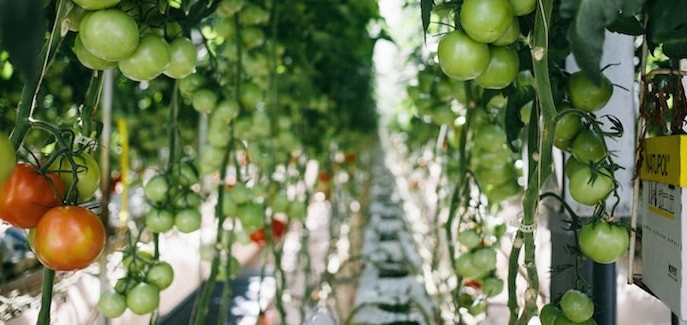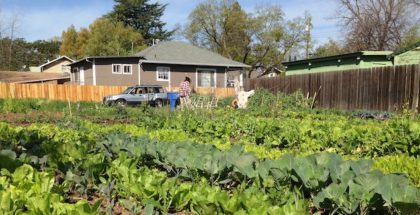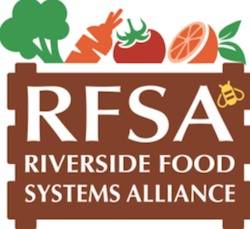Experts Weigh in: While Hydroponic Growing Techniques Offer Incredible Benefits, We Still Need Dirt
March 16, 2016 | AJ Hughes

Tomato plants grow in the soil. (Wikimedia Commons photo)
Traditionally, farmers have grown plants in nutrient-rich soil. Now an increasing number of growers are utilizing hydroponic growing systems, which use a variety of soil-less media in a controlled environment.
But which is better—soil or soil-free?
Seedstock ventured to find an answer to this question by talking to a farmer, a hydroponics expert, a horticulturist and a chef. They each have different opinions, but one thing is clear: while soil-less growing techniques can offer incredible benefits, we still need dirt.
Here’s what they had to say.
A Farmer’s Perspective
To start, we found a farmer who has utilized (and still does, to some extent) both approaches—Darin Kelly of Good Life Farms, located in Eminence, Indiana.
Kelly sees five distinct ways he has benefited from hydroponics—being able to grow year-round, quicker yields, greater efficiency of space, less water usage, and better consistency of product.
Kelly, who still uses soil to grow heirloom tomatoes, has grown hydroponically for about seven years. He was curious about this method, and was offered some cheap used hydroponic channels from American Hydroponics. Thus his learning curve began.
One of the first things he learned is that growing in soil is much easier than hydroponic growing.
“Hydroponics is technical, and not simple,” he says. “You’ve got to worry about plumbing, slope, pressure, and measuring nutrients. You become a plumber, you become an electrician.”
He also found that growing hydroponically can quickly become expensive due to cost of equipment and lighting.
But despite these challenges, Kelly has embraced hydroponics. Growing in a controlled environment has enabled him to produce food year-round in a region of the U.S. that is hallmarked by frigid winters. He’s also seen faster yields, regardless of season.
“Our arugula went from seed to harvest in just over three weeks, and butter lettuce took just over six weeks,” he says. “I could never do that in soil.”
Bolstering these speedy harvests is the economy of space that hydroponics provides. Even though Kelly’s greenhouse measures only 3,100 square feet, it produces 100,000 head of lettuce each year, plus large quantities of basil and arugula.
“That’s incredible for that size of space,” he says.
Despite the extra financial outlay associated with hydroponic growing, Kelly says this method requires much less water than growing in soil. Crediting closed hydrating channels for minimal evaporation, he uses about 80 percent less water with hydroponics.
Acknowledging that both soil and hydroponics can produce high-quality and low-quality crops, Kelly believes that greater consistency can be attained through hydroponic growing.
“Plants aren’t exposed to pathogens, and it’s easier to dial in what the plant needs,” he says.
Despite these advantages, Kelly has not written off soil.
“Soil growing is not cost-prohibitive,” he says. “Another benefit of soil is there is a small group of people who are not accepting of hydroponic growing.”
“I like soil, too,” he says.
A Hydroponic Expert Weighs In
Bob Hochmuth serves as director of the Suwannee Valley Agricultural Extension Center in Florida, and specializes in vegetable growing. He sees major advantages in hydroponics, especially in regions with certain types of soils.
“In Florida we have very sandy soil, with not much organic matter,” Hochmuth says. “Florida soils need inputs, so hydroponics can put a favorable model in place.”
Hydroponics, he says, also allows growers to avoid harmful insects and nematodes, which can result in crop loss.
And despite the expense of getting a hydroponic operation up-and-running, Hochmuth says hydroponics attracts many new farmers, most of whom lack access to large plots of land.
“You don’t need a tractor or a plow or other big implements, and you don’t need to inherit a farm,” he says. “You can get in very quickly, and can maintain another job.”
Hochmuth also gives the nod to hydroponics when it comes to food safety and avoidance of pathogens, such as E. coli and salmonella, that are spread by animal droppings and manure.
“In a greenhouse, there are no birds and no wildlife,” he says. “This cuts down on risk.”
It’s common knowledge that commodity crops such as corn and soybeans can’t be grown profitably in a hydroponic system. Therefore, according to Hochmuth, hydroponic operations need to specialize in high-value crops such as herbs, vegetables, fruits, flowers and microgreens.
Some believe, though, that these hydroponically-grown fruits, vegetables and greens aren’t as tasty as their soil-grown counterparts—but Hochmuth says much progress has been in this area.
“Hydroponic varieties have not been out as long as soil-grown varieties,” he says. “Thirty years ago, taste would have been an issue.”
Even though hydroponics offers its share of positives, Hochmuth points to challenges facing hydroponic growers. Because it’s difficult to come up with the right nutrient program, hydroponics is not well-suited for organic production. Zoning laws can be difficult to navigate. Insurance is often needed for greenhouse structures. And, there is a need for skilled workers who are adept at the technology required by hydroponic operations.
A Horticulturist’s Take
Growers and scientists are still on a learning curve in comparing hydroponic growing to growing with soil, according to horticulturist Carl Rosen, who also serves as head of the University of Minnesota Department of Soil, Water, and Climate.
“Hydroponics has basic building blocks, but there are subtle aspects to soil that are still not well-quantified,” says Rosen. “We’re just now learning what soil microbes might be doing. We’re still learning what these interactions are.”
Rosen is interested in conducting a nutritional analysis of food grown hydroponically versus food grown in soil. As hydroponics and other forms of controlled-environment agriculture continue to rise to the forefront, he expects a plethora of forthcoming associated nutritional research.
Nutrition notwithstanding, Rosen says those who use soil to grow their crops enjoy a much wider margin for error, as well as lower maintenance requirements.
“In hydroponics, you’ve got to provide everything,” he says. “You also must have excellent monitoring.”
Ultimately, Rosen says hydroponics will play a key role in food production, but cannot and will not ever take the place of soil.
“I’m not sure it will save the world in terms of food supply because of the cost involved,” he says. “There’s a niche for it, but it’s not the savior of the world.”
A Chef’s View
Erik Oberholtzer, co-founder of local- and sustainable-centric restaurant group Tender Greens, relies quite a bit on hydroponic produce. But in a perfect world, he would prefer food that comes from the earth. But he knows imperfect growing conditions make hydroponics a necessary reality.
“If you have great soil, then soil is better. Just as wine takes on the characteristics of ‘terroir’, so do vegetables. That said, not all soil is created equal, and climate plays a big role as well.”
Tender Greens uses both soil-grown and hydroponically-grown produce, and Oberholtzer points to the benefit of using consistent high-quality produce that comes out of hydroponic farms. However, he hopes people can celebrate both types of growing.
“Most chefs prefer the romanticism of soil, and I do not differ from this perspective,” he says. “That said, I also value the positive influence of hydroponics, urban farming, and controlled-environment agriculture in solving some of the big problems we face. This story should be shared and celebrated with the same romance as the biodynamic farm with pristine soil and coastal climate conditions.”












Submit a Comment